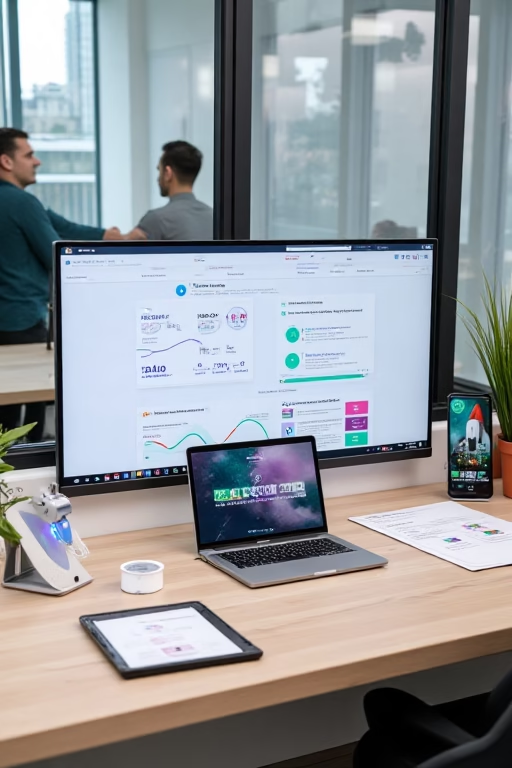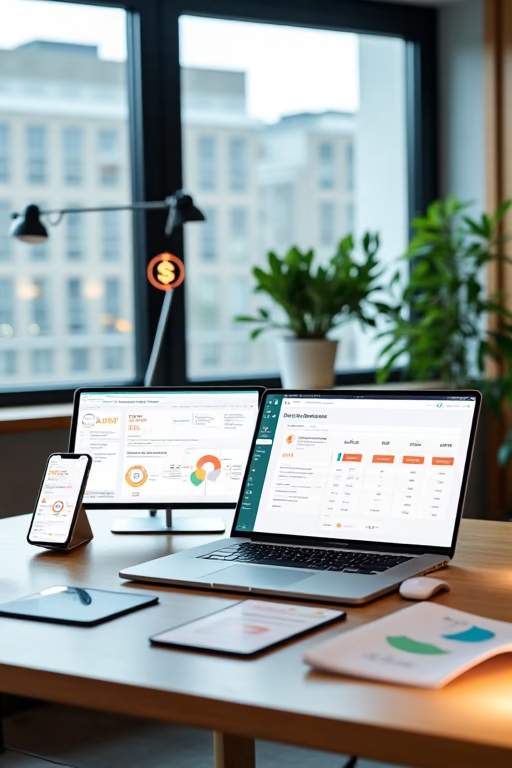Best AI for Local Business Lead Generation
Best AI for Local Business Lead Generation
Your Guide to Cutting‑Edge Lead Capture & Nurture by Market Wiz
Table of Contents
- Introduction: The AI Advantage
- 1. Understanding AI for Lead Generation
- 1.1 Why Local Businesses Need AI
- 1.2 How AI Improves Lead Quality
- 2. Top AI Tools for Lead Capture
- 2.1 Conversational Chatbots
- 2.2 Predictive Prospecting Platforms
- 2.3 AI‑Driven Email Sequencers
- 2.4 Automated CRM Workflows
- 2.5 Analytics & Predictive Scoring
- 3. Implementation Steps
- 3.1 Assess Your Lead Flow
- 3.2 Select & Integrate Tools
- 3.3 Train & Configure AI Models
- 3.4 Launch & Optimize
- 4. Best Practices & Pitfalls to Avoid
- 5. Measuring Success & ROI
- Conclusion & Next Steps
- 25 Frequently Asked Questions
- 25 Extra Keywords
Introduction: The AI Advantage
Local businesses often struggle to keep pace with lead inquiries, follow‑up, and nurturing. AI tools automate routine outreach, qualify prospects instantly, and surface high‑intent contacts—letting you focus on closing rather than chasing. In this guide, we explore the best AI platforms to supercharge your local lead generation in 2025.
1. Understanding AI for Lead Generation
1.1 Why Local Businesses Need AI
With limited marketing resources and high competition, local businesses benefit from AI’s 24/7 availability—capturing leads at all hours and ensuring no inquiry goes unanswered.
1.2 How AI Improves Lead Quality
AI analyzes behavior data to predict which leads are most likely to convert, prioritizing follow‑up and tailoring messaging based on visitor intent and demographics.
2. Top AI Tools for Lead Capture
2.1 Conversational Chatbots
ManyChat, Tidio, and Drift embed on your website or social channels to greet visitors, answer FAQs, and collect contact details—qualifying leads before a human steps in.
2.2 Predictive Prospecting Platforms
Leadfeeder and Clearbit uncover anonymous website visitors and enrich profiles, giving you contact data and intent signals for outbound campaigns.
2.3 AI‑Driven Email Sequencers
Mailshake, Lemlist, and Woodpecker automate personalized cold and nurture emails, optimizing send times and subject lines with machine‑learning insights.
2.4 Automated CRM Workflows
HubSpot Workflows, Zoho Blueprint, and Pipedrive Automations manage lead routing, follow‑up reminders, and task assignment—ensuring timely engagement.
2.5 Analytics & Predictive Scoring
6sense and MadKudu apply predictive models to score leads by conversion probability, helping you focus on high‑value prospects and allocate resources smartly.
3. Implementation Steps
3.1 Assess Your Lead Flow
Map out current channels—website forms, calls, social messages—and identify gaps in response time or data capture.
3.2 Select & Integrate Tools
Choose tools covering chat, email, CRM, and analytics. Use native integrations or Zapier to connect systems for seamless data sync.
3.3 Train & Configure AI Models
Feed historical data into your AI platforms; define intent keywords, qualification criteria, and persona segments for accurate lead scoring.
3.4 Launch & Optimize
Deploy chatbots and email sequences with a pilot audience. Monitor key metrics—response rate, MQL conversion—and refine flows weekly.
4. Best Practices & Pitfalls to Avoid
- Human Oversight: Review AI-generated leads daily to catch false positives.
- Clear Opt‑Out: Always provide easy unsubscribe options in automated outreach.
- Data Hygiene: Regularly clean your contact lists to avoid duplication and stale records.
- Gradual Rollout: Start with one channel before scaling AI to all touchpoints.
5. Measuring Success & ROI
- Lead Capture Rate: % increase in form submissions and chat interactions.
- Response Time: Average time from inquiry to first reply.
- Qualified Leads: MQLs per month compared to manual baseline.
- Conversion Rate: % of AI‑captured leads that convert to customers.
- Cost per Lead: Total tool spend ÷ new leads generated.
Conclusion & Next Steps
AI-driven lead generation levels the playing field for local businesses—automating outreach, qualification, and nurturing to deliver a steady pipeline. Identify your highest‑volume channels, choose complementary AI tools, and launch a pilot this week. Monitor performance, refine models, and watch your lead volume and quality soar.
25 Frequently Asked Questions
1. What is AI lead generation?
Using artificial intelligence to capture, qualify, and nurture leads automatically across digital channels.
2. Do I need coding skills?
No—most modern AI platforms offer no-code setups and drag‑and‑drop builders.
3. What channels work best?
Website chat, email outreach, social messaging, and CRM workflows yield strong local results.
4. How much does it cost?
Entry-level plans range \$15–\$60/month per tool; a full stack typically under \$300/month.
5. Is human follow‑up required?
Yes—AI handles qualification but high‑value or complex leads benefit from a personal touch.
6. How to avoid spam filters?
Implement frequency caps, personalize messages, and include clear unsubscribe links.
7. Can AI score leads accurately?
With clean training data and well‑defined criteria, predictive models can achieve 80%+ accuracy.
8. Do chatbots handle slang?
Advanced NLP bots understand common variations; review logs to refine intent recognition.
9. How to integrate with my CRM?
Use native connectors or middleware like Zapier to push data into HubSpot, Zoho, or Pipedrive.
10. Are free trials available?
Yes—most AI platforms offer 7–30 day trials to test core features risk‑free.
11. What metrics matter most?
Response time, MQL rate, conversion rate, and cost per lead are key indicators.
12. Can AI personalize messaging?
Yes—dynamic tokens and segmentation enable one‑to‑one personalization at scale.
13. How often update AI models?
Review quarterly and retrain with new data to maintain accuracy.
14. Does AI work offline?
AI tools require internet access; dashboards are often mobile‑responsive for on‑the‑go monitoring.
15. How to handle opt‑outs?
Respect unsubscribe requests immediately and remove contacts from all automated flows.
16. Are multilingual bots possible?
Yes—select platforms with built‑in language packs or custom intent training for additional languages.
17. What about data privacy?
Choose GDPR/CCPA‑compliant vendors and secure customer data with encryption and access controls.
18. Can AI handle appointment booking?
Yes—chatbots and workflows can integrate with Calendly or Acuity to schedule calls automatically.
19. How to measure ROI quickly?
Compare lead volume and MQL conversion before vs. after AI implementation over a 30‑day period.
20. Will AI replace my marketing team?
AI augments human efforts—freeing marketers for strategy, creativity, and high‑impact tasks.
21. How to avoid over‑automation?
Maintain human review checkpoints and limit fully autonomous campaigns initially.
22. What’s the learning curve?
Plan for 1–2 weeks per tool; vendor support and templates accelerate onboarding.
23. Can AI optimize budgets?
Advanced platforms reallocate spend in real time based on channel performance and cost targets.
24. Are there industry‑specific solutions?
Yes—some AI tools tailor models for sectors like real estate, healthcare, and retail.
25. What’s the first step?
Identify your highest‑volume lead source, pilot a chatbot or email sequencer, and track initial impact.
25 Extra Keywords
- local AI lead capture
- chatbot for lead gen
- predictive lead scoring
- AI email sequence
- CRM workflow automation
- no-code AI marketing
- lead enrichment AI
- MQL predictive model
- real-time lead engagement
- AI appointment scheduling
- GDPR compliance AI
- WhatsApp chatbots
- SMS lead automation
- AI analytics dashboard
- conversion rate AI
- HubSpot AI features
- Zoho AI automation
- Pipedrive AI sales
- Zapier AI integrations
- AI marketing ROI
- AI content personalization
- lead nurturing AI
- voicebot lead capture
- AI demo lead funnel
- Market Wiz AI guide






